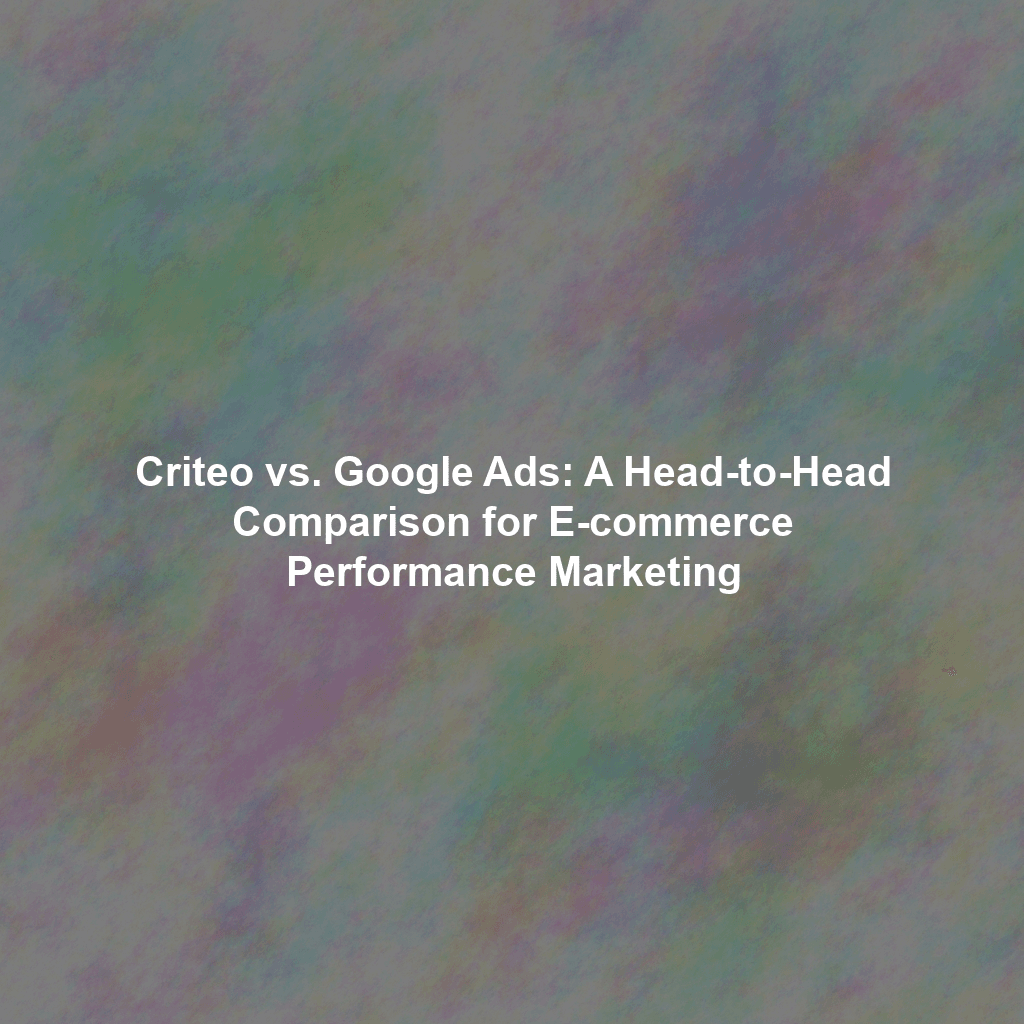In the competitive world of e-commerce, choosing the right advertising platform can make or break your online business. Two titans frequently vying for marketing dollars are Criteo and Google Ads. While both aim to drive sales, they approach the task with distinct strategies and capabilities. This article provides a detailed head-to-head comparison, focusing on key aspects like targeting, bidding, reporting, and ROI, to help you determine which platform best aligns with your specific e-commerce goals and budget.
Targeting Capabilities: Reaching the Right Audience
Criteo: The Retargeting Powerhouse
Criteo excels in retargeting. It leverages sophisticated algorithms and a vast network of publisher websites to show personalized ads to users who have previously interacted with your website. This focus on users with demonstrated purchase intent makes Criteo highly effective at converting window shoppers into buyers. Criteo’s dynamic product ads (DPAs) are a cornerstone of their strategy, displaying products that users have viewed, added to their cart, or shown interest in. Furthermore, Criteo can also find new customers using lookalike audiences, which target users with similar browsing behavior to your existing customer base.
Google Ads: Broad Reach with Granular Control
Google Ads, on the other hand, offers a much broader range of targeting options. Through Search Ads, you can target users actively searching for specific products or services. Display Ads extend your reach across a vast network of websites and apps, utilizing contextual targeting, audience targeting (including demographics, interests, and in-market segments), and retargeting. Google Shopping campaigns showcase your products directly in search results, allowing users to quickly compare prices and make purchases. Google Ads provides incredibly granular control over your targeting, allowing for highly specific audience segmentation and message tailoring.
Bidding Strategies: Optimizing for ROI
Criteo: AI-Powered Optimization
Criteo primarily relies on automated bidding strategies driven by artificial intelligence. Its algorithms analyze user behavior and historical data to optimize bids in real-time, maximizing conversion rates and return on ad spend (ROAS). While you can set target ROAS goals, Criteo largely manages the bidding process for you, requiring less manual intervention. This hands-off approach can be beneficial for marketers with limited time or expertise in bid management.
Google Ads: Flexibility and Control
Google Ads offers a wide array of bidding options, from manual cost-per-click (CPC) bidding to automated strategies like Target CPA (cost per acquisition), Target ROAS, and Maximize Conversions. This flexibility allows marketers to tailor their bidding approach to their specific goals and risk tolerance. While automated bidding strategies are increasingly sophisticated, Google Ads also empowers marketers to maintain granular control over their bids and make adjustments based on performance data.
Reporting and Analytics: Measuring Performance
Criteo: Focus on Post-Click Conversions
Criteo’s reporting primarily focuses on post-click conversions and revenue attribution. It provides detailed insights into the performance of your retargeting campaigns, including metrics like click-through rate (CTR), conversion rate, ROAS, and average order value (AOV). While Criteo also offers some attribution modeling, its strength lies in measuring the direct impact of its ads on sales.
Google Ads: Comprehensive Data and Attribution Modeling
Google Ads offers a more comprehensive suite of reporting and analytics tools. You can track a wide range of metrics, including impressions, clicks, CTR, conversion rate, cost per conversion, ROAS, and more. Google Ads also provides robust attribution modeling capabilities, allowing you to understand how different touchpoints contribute to conversions. This holistic view of the customer journey can help you optimize your marketing efforts across all channels.
Strengths and Weaknesses: The Verdict
Criteo: Strengths and Weaknesses
- Strengths: Highly effective retargeting, AI-powered optimization, ease of use, strong ROAS for remarketing campaigns.
- Weaknesses: Limited targeting options beyond retargeting, less control over bidding, less comprehensive reporting than Google Ads.
Google Ads: Strengths and Weaknesses
- Strengths: Broad reach, granular targeting, flexible bidding options, comprehensive reporting, strong for both acquisition and remarketing.
- Weaknesses: Can be complex to manage, requires more manual optimization, competition can drive up costs.
When to Choose Criteo vs. Google Ads
Criteo is a Better Fit When:
- Your primary goal is to retarget existing website visitors and convert them into buyers.
- You want a hands-off approach to bid management and optimization.
- You have a large product catalog and want to leverage dynamic product ads.
Google Ads is a Better Fit When:
- You want to reach a broad audience and acquire new customers.
- You need granular control over targeting and bidding.
- You want a comprehensive view of your marketing performance across all channels.
- You want to capitalize on user intent through search advertising.
Case Studies and Examples
Example 1: Small E-commerce Business (Budget Constraints): A small e-commerce store selling handmade jewelry might start with Google Shopping campaigns to capture users searching for specific types of jewelry. Once they’ve built up website traffic, they can then implement Criteo to retarget visitors who viewed products but didn’t purchase.
Example 2: Large E-commerce Retailer (Established Brand): A large retailer with a well-established brand might use Google Ads for both acquisition (through Search and Shopping campaigns) and remarketing (through Display Ads). They might also use Criteo to supplement their remarketing efforts, particularly for dynamic product ads. They could compare the ROAS of their Google Ads remarketing versus their Criteo remarketing to determine which platform is performing better and allocate their budget accordingly.
Conclusion: A Synergistic Approach
Ultimately, the best choice between Criteo and Google Ads depends on your specific e-commerce goals, budget, and resources. In many cases, a synergistic approach – using both platforms in conjunction – can yield the best results. Google Ads can drive initial traffic and awareness, while Criteo can recapture lost sales and maximize conversion rates. By understanding the strengths and weaknesses of each platform, you can create a winning performance marketing strategy that drives growth and profitability for your e-commerce business.
 Skip to content
Skip to content

